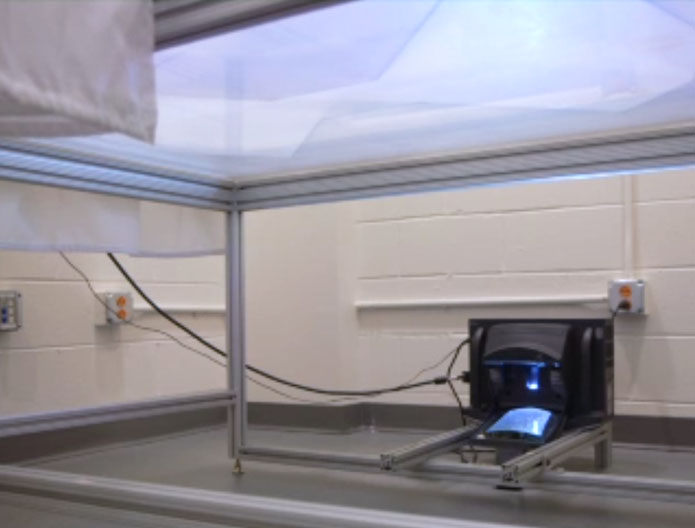PROVIDENCE, R.I. [Brown University] — A rodent in a maze is a staple — even a stereotype — of experimental psychology research. But the maze in the lab of Rebecca Burwell, professor of cognitive, linguistic, and psychological sciences at Brown University, is not your grandfather’s apparatus. In a new video article published in the Journal of Visualized Experiments, Burwell’s research group demonstrates in full detail how the maze can be used to perform automated visual cognitive research tasks with great efficiency.
The maze is part real and part virtual. There are actual walls – often in the shape of a giant piece of farfalle – but researchers can project any imagery they want onto the floor from below. The use of digital projections makes the maze versatile, but using the floor for projections makes it particularly well-designed for rodent subjects.
“We’ve known since Lashley’s classic studies on the mechanisms of vision that rats pay more attention to stimuli presented near the ground, but the field has persisted in presenting vertical 2-D images or 3-D objects,” Burwell said. “What's new is the idea that presentation of images to the ground is the best way to present stimuli to rats and mice. Rodents do not have a fovea [a small depression in the retina where visual acuity is highest] like primates do, but they do have more retinal ganglion cells and photoreceptors in the upper retina, indicating that they can see items in the lower visual field better.”

The system makes a real difference in the speed with which rats learn tasks in the maze, Burwell said. In different experiments, the article notes, rats have learned to respond properly to visual stimuli in a fourth to a sixth the number of trials when stimuli were projected onto the floor rather than onto walls.
While rodents behave in the maze, they are tracked with an overhead camera and software that monitors their behavior. Implanted neural sensors in the rodents’ brains allow for precise recording of brain activity during sessions so that it can be correlated with behavior.
Implants also allow for delivery of a rewarding stimulus. Rewards sent directly to the brain can be more effective than food rewards, Burwell said, because rats can be rewarded in the moment of desired performance, and they don’t become satiated.
Burwell first published a paper about the floor projection maze in 2009 and has been using it ever since. She owns the intellectual property and said a company is interested in licensing it.
“For anyone interested in using rats or mice as a model for visual information processing, presenting the information on the floor makes good sense behaviorally and biologically,” she said.
The Brown University Institutional Animal Care and Use Committee must approve research protocols involving animals, including the floor projection maze.
The research is supported by the National Science Foundation (grants IOS 1146334, EFRI 0937848, IOS 0522220), and the Defense Advanced Research Projects Agency (N66001-10-C-2010).
